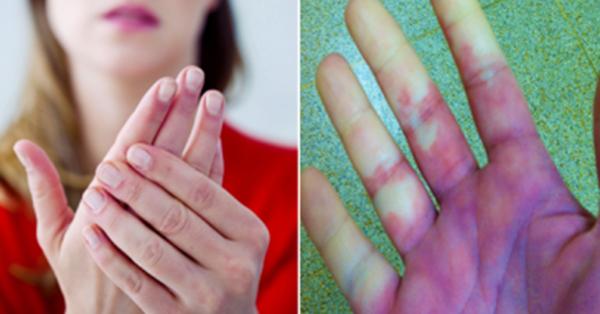Always cold hands and feet? : our solutions to protect them
Brrrr… We're freezing! But some more than others, without being able to warm their hands and feet, sometimes even their ears and the tip of their nose. The skin sometimes even changes color, turns bluish as a sign of lack of oxygen when the blood runs out, or even white when it really does not circulate at the end of certain phalanges or toes. Not to mention the more frequent frostbite to the lower extremities; or tingling when the heat finally returns. It is often benign, but unpleasant. You should consult the doctor when the discomfort is too great and when the symptoms evolve, become asymmetrical and are accompanied by discomfort. Explanations and advice from Dr Matthieu Josnin, vascular doctor at the Saint-Charles Clinic in La-Roche-sur-Yon.
Why so cold?
Low temperatures have a vasoconstrictor effect. The small vessels contract, the hot blood circulates less and the skin cools, especially in the event of ambient humidity or generated by sweating. We are all confronted with it, but in the event of specific capillary fragility, the phenomenon is more significant and lasting.
It is also accentuated by stress, also vasoconstrictor, such as by immobility reinforcing the stagnation of fluids, or by driving when both hands remain clutching the cold steering wheel, in the high position. And beware of smoking, which harms the health of the vessels!
In addition to these aggravating factors, a pathology may also be underlying, which a clinical examination and of the capillaries, sometimes associated with a Doppler and a blood test, can diagnose.
When a disease is involved
* The extremities are blue? It's probably acrocyanosis. It is a benign vascular disease characterized by the blueness of the extremities and the feeling of cold, most often observed in young women and which is explained by an immaturity of the capillary network. The problem most often passes on its own with age.
* The skin suddenly turns white? It's probably Raynaud's disease. In this case, the cold generates a spasm in the small vessels which suddenly expels the blood, leaving the skin white and icy. We think of it when the two limbs are affected symmetrically, and at certain lateral phalanges, the thumbs being protected by highly vascularized muscles. And especially if other people in the family experience the same symptoms, heredity being important. Rest assured, it is also not serious, but you will have to learn how to protect yourself well from the cold to avoid frostbite, accompanied by itchy edematous plaques, for severe forms. Be careful, if these symptoms occur spontaneously and late without a family history, even in summer, it may be Raynaud's syndrome derived from another pathology to be detected.
Dog Care Tips: How to Treat a Dog With a Cold | Doggy Meal: Caring is the Key - Dog Care - Toddler Light-Pink-T-S... http://bit.ly/9Gx71h
— fwresh Sun Mar 14 20:41:09 +0000 2010

* Is it mostly on one side? It may be scleroderma, a rather rare autoimmune disease that appears around the age of 50-60 and leads to the destruction of micro-vessels. It is frequently manifested by an asymmetrical but severe Raynaud's syndrome, and fibrosis of the skin which is sometimes accompanied by lesions. The consultation is an opportunity to make an overall assessment and investigations on the lungs and heart.
* Are your fingers permanently bloodless? This can signal digital arteritis, usually caused by smoking and cannabis use. The capillaries are this time destroyed after obstruction, most often generated by an inflammatory phenomenon localized in the small arteries of the fingers. The symptom of cold hands and/or feet is then permanent and perceived on one side only, regardless of the ambient temperature. Prompt medical attention is needed to save the limb.
* Is discomfort associated? Watch out for thrombosis. A clot may clog a nearby artery and block the flow of blood downstream, in the finger or toe. The area is cold, dizziness and a feeling of fatigue set in, and it is urgent to consult for a thorough vascular examination.
Good support
* To treat: While there are no cures for Raynaud's disease, calcium channel blockers can still dilate the vessels to increase blood flow. And against acrocyanosis, iontophoresis sessions (exposure to an electric current) can help. Greater and comprehensive medical care is needed for other pathologies, and in the case of scleroderma, corticosteroids and aspirin are proposed in particular to improve the symptoms of cold limbs. As for thrombosis and digital arteritis, they often require occasional hospitalization to also assess the complications, and administer specific vasodilator drugs.
* To prevent: Whatever the cause of the symptoms, it is essential to protect yourself from the cold with superimposed layers of fine clothing, always avoiding compression. Except for the lower legs, in case of proven venous insufficiency, responsible for icy feet in winter. There, compression socks or tights improve the sensation. Otherwise, more protective technical materials are needed (ski socks, fleece-lined gloves, etc.). We finally think of covering the chest rich in thermal sensors. Exposure to cold on this remote area may be responsible for triggering Raynaud's syndrome.
What if it was an allergy to the cold?
Sometimes the cold triggers an attack of hives, accompanied by itchy red patches on the parts of the body most exposed to the cold (hands, feet, face). The phenomenon is therefore not vascular, but it is not really allergic either, in the absence of the allergen in question. Nevertheless, prevention and treatment go through the taking of antihistamine drugs. And as with an allergy, desensitization can be considered.









